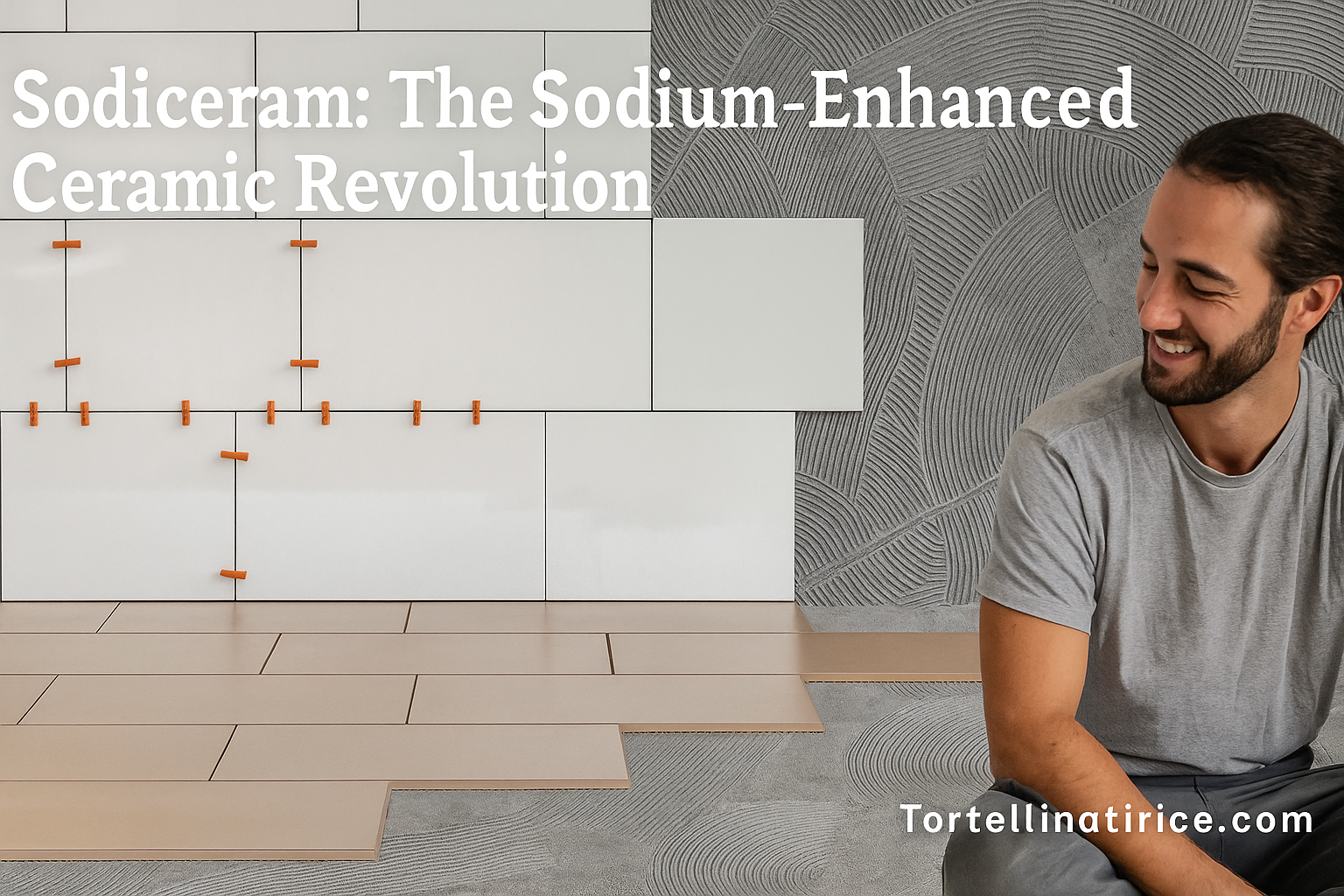Introduction
In 2025, sodiceram has emerged as a powerful force in modern ceramics. Blending advanced chemistry with durability and design, Sodiceram redefines how we think about tiles, surfaces, and material performance.
1. What Is Sodiceram?
Definition and Composition
Sodiceram ceramics are built from clay, feldspar, silica, alumina, and sodium-based compounds like sodium oxide or silicates. These ingredients undergo precision sintering—high-temperature firing—to produce dense, low-porosity material. The sodium compounds enhance vitrification and reduce porosity and thermal expansion.
Name and Origin
The name “Sodiceram” fuses “sodi” (from sodium) and “ceram” (from ceramic), signaling the blend of chemistry and tradition. While rooted in centuries-old craftsmanship, the material’s current form springs from recent innovations in material science and European design labs.
2. Key Properties and Advantages of Sodiceram
Durability & Strength
Sodiceram tiles are exceptionally strong, resisting chipping, cracking, and abrasion far more effectively than standard ceramics.
Thermal Shock and Heat Resistance
These sodiceram ceramics endure rapid temperature shifts—perfect for kitchens, exteriors, or industrial uses.
Water, Stain & Chemical Resistance
Thanks to low water absorption and chemical inertness, Sodiceram floor tiles resist stains, moisture, and even harsh cleaners.
Lightweight & Easy Installation
Despite their strength, Sodiceram wall tiles are lighter than many traditional alternatives. That makes handling and installation easier, especially for vertical surfaces.
Design Flexibility
Available in finishes like matte, satin, polished, or structured grip, and visuals that mimic stone, wood, terrazzo, or concrete, Sodiceram porcelain products offer vast aesthetic options.
Sustainability
Lower firing temperatures, recycled content, reduced waste, and long lifespan make Sodiceram an eco-conscious choice.
3. Comparison: Sodiceram vs Traditional Ceramics
| Property | Sodiceram | Traditional Ceramics |
| Durability | High, resistant to wear | Variable, more prone to cracks |
| Water Absorption | Low (non-porous) | Often higher |
| Heat Resistance | Excellent | Varies by type |
| Chemical Resistance | Strong | Moderate |
| Weight | Lightweight | Often heavier |
| Design Options | Broad (finishes, textures) | Generally limited |
| Sustainability | High (efficient, low waste) | Often lower |
4. Applications Across Spaces and Industries
Residential Use
- Kitchens: Ideal for countertops, splashbacks, and flooring, thanks to heat and stain resistance.
- Bathrooms: Structured finishes suit wet zones; low porosity prevents mold and staining.
- Living Areas: Large, sleek sodiceram floor tiles add modern flair and durability.
Commercial & Hospitality
- Lobbies, corridors, cafés, and retail spaces benefit from easy cleaning, stylish surfaces, and high traffic tolerance.
Outdoor Installations
- Patios, covered facades, and exteriors gain from freeze-thaw resistance, UV stability, and slip-resistant finishes.
Industrial and Specialty Applications
- Used in machinery liners, furnace parts, and chemical plant surfaces where heat, abrasion, and corrosives are common.
High-Tech Industries
- Found in automotive heat shields, aerospace panels, electronics insulators, and medical devices.
Artistic and Design Projects
- Used in decorative walls, custom mosaics, and narrative-driven design—Sodiceram tiles become art.
5. Choosing and Caring for Sodiceram
Selection Tips
- Identify performance needs first—wet areas, heat exposure, heavy traffic.
- Choose finishes wisely: structured or matte for slip resistance, polished for aesthetics in low-use areas.
- Explore design collections—concrete look, stone look, or decorative ceramic murals.
Installation
- Use professional installers familiar with Sodiceram specifications, adhesives, grout, and movement joints.
- For large or complex installations, seek technical guides and manufacturer advice.
Maintenance
- Clean with mild soap and water; avoid abrasive tools or harsh chemicals.
- Generally, sealing isn’t needed due to low porosity, but always follow product specifics.
6. Challenges and Considerations
- Higher Initial Cost: Superior materials and tech may cost more up front, though long-term savings often justify them.
- Limited Availability: As a newer material, sodiceram may be hard to source in some regions.
- Handling Delicacy: Despite its strength, like other ceramics, it can crack if dropped or installed improperly.
7. The Future of Sodiceram
- 3D Printing & Nanotechnology: Leads to custom shapes and enhanced strength.
- Smart and Green Architecture: Expect integration into eco-buildings and smart surfaces.
- Expanded Industry Reach: From aerospace to electronics, sodiceram is paving new paths.
Conclusion
Sodiceram stands at the forefront of modern ceramic innovation. It delivers a winning mix of durability, heat and chemical resistance, design versatility, and sustainability. Whether for home interiors, commercial settings, or advanced industrial uses, Sodiceram tiles, ceramics, floor tiles, wall tiles, and porcelain lines elevate both form and function. Its growing adoption speaks to a future where materials perform and inspire.
FAQs
1. What exactly is Sodiceram made of?
It’s composed of clay, feldspar, silica, alumina, and specialized sodium-based compounds—like sodium oxide—to create strong, dense ceramics.
2. Are Sodiceram products eco-friendly?
Yes—thanks to lower firing temperatures, waste reduction, recyclable content, and long lifespan, they support sustainable construction goals.
3. Can I use Sodiceram outdoors?
Absolutely. Its UV stability, freeze-thaw resistance, and textured finishes make it ideal for outdoor floors, patios, and facades.
4. Is it more expensive than regular tiles?
It typically costs more upfront due to advanced manufacturing—but its durability, low maintenance, and longevity often yield better value over time.
5. What makes Sodiceram unique compared to regular ceramics?
Its sodium-enriched formula gives it better strength, lower porosity, superior heat and chemical resistance, lighter weight, and broader design choices than conventional ceramics.
